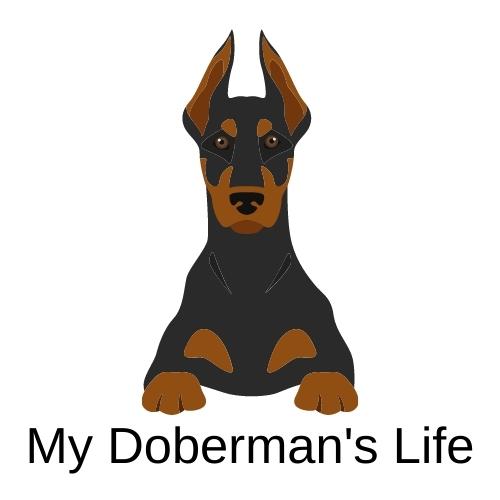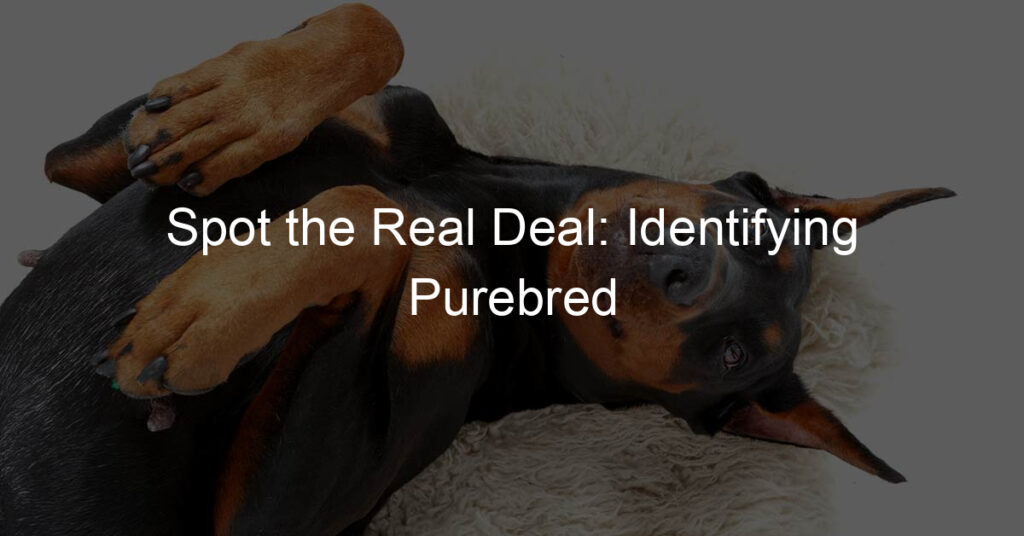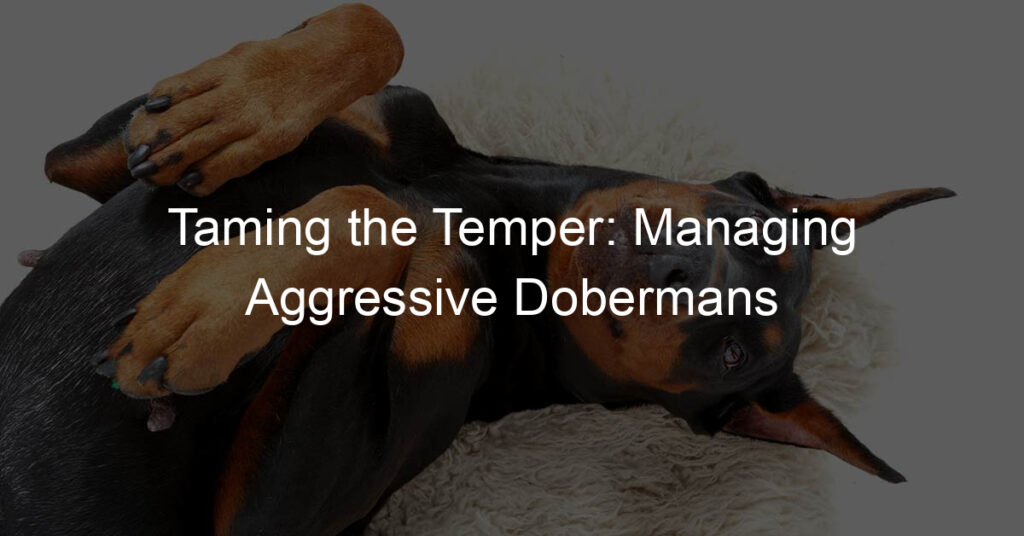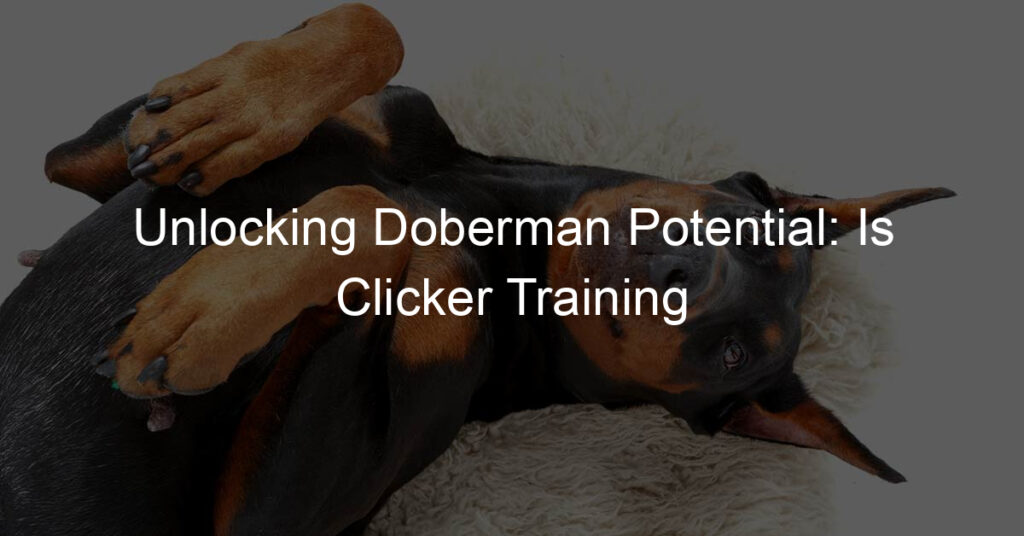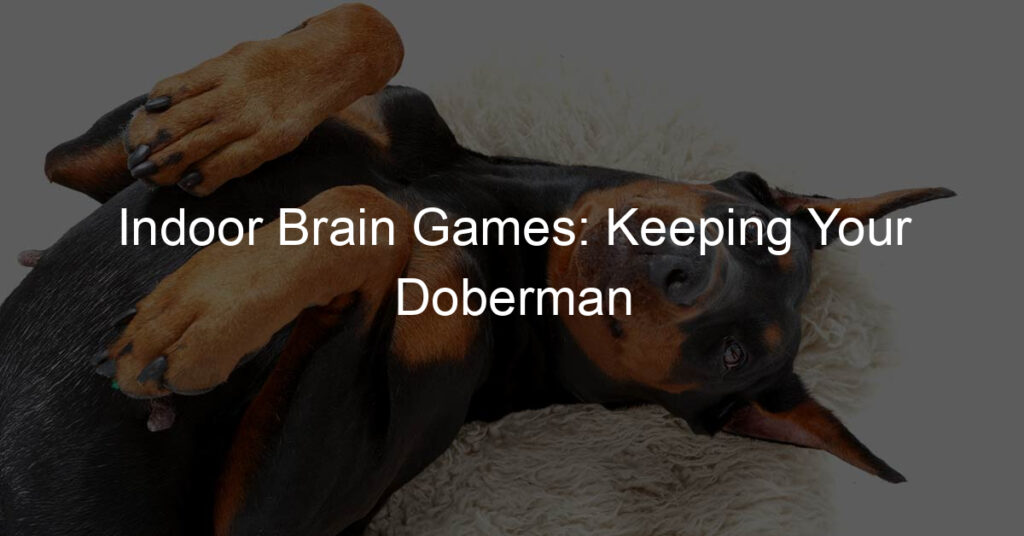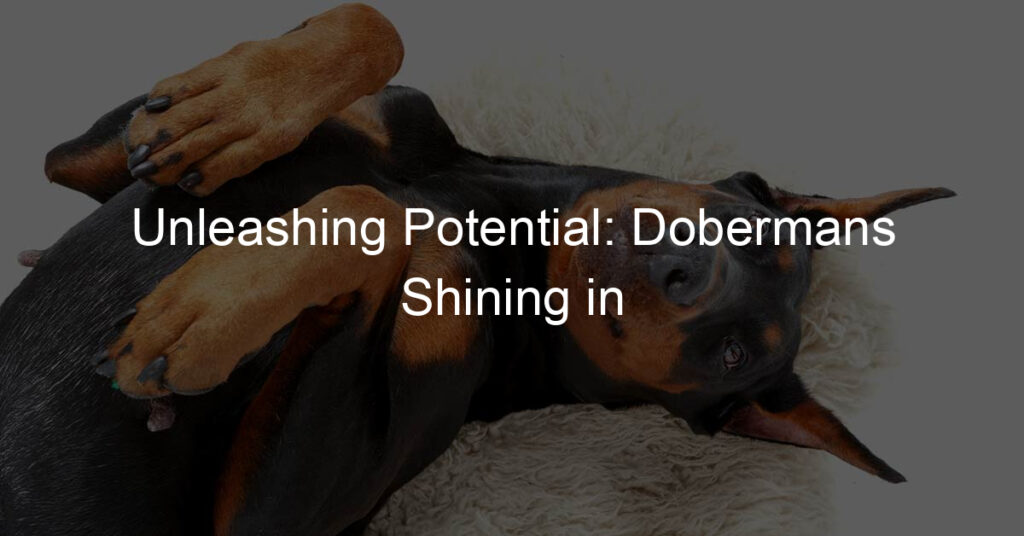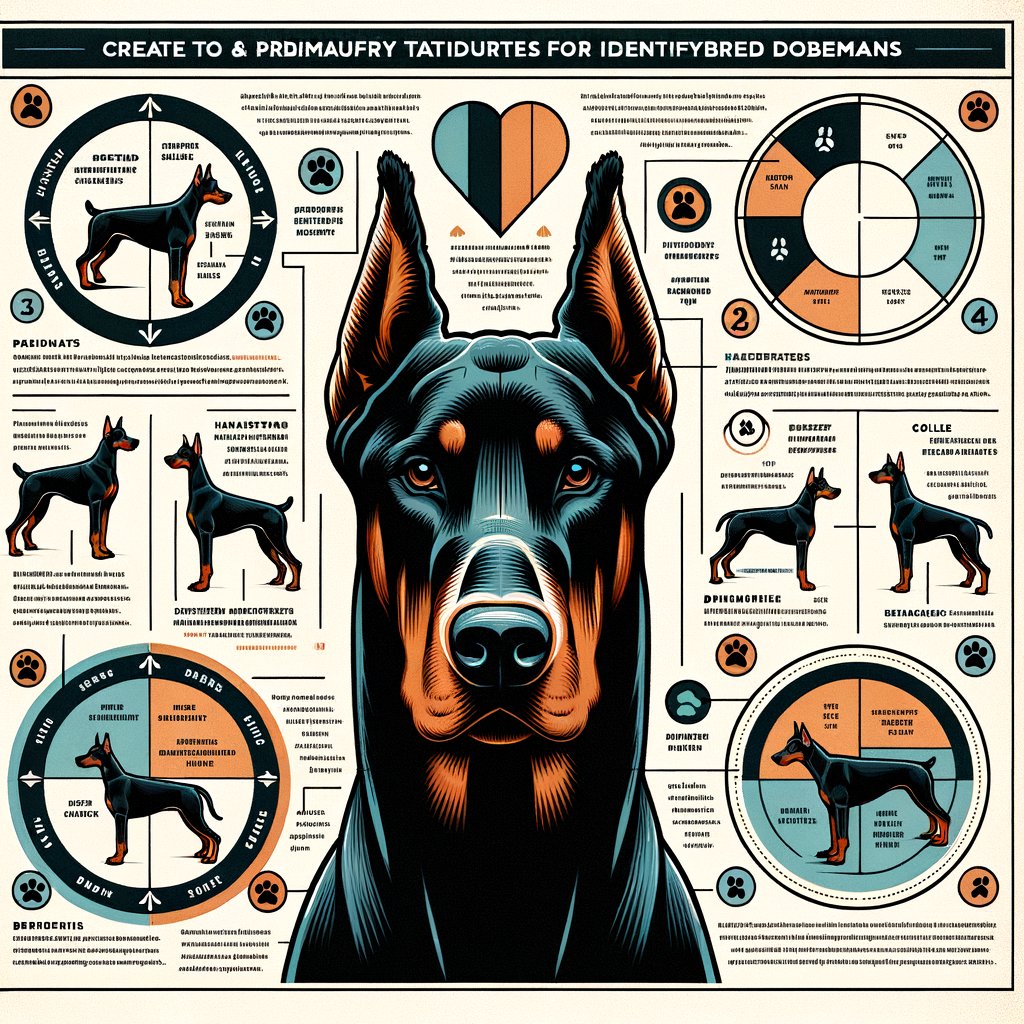
Introduction to Purebred Dobermans
Dobermans are a fascinating breed of dogs, known for their loyalty, intelligence, and strong protective instincts. But what makes a Doberman a purebred? Let’s dive into the history of this breed and understand the importance of purebred identification.
- History of the Doberman Breed
- Importance of Purebred Identification
The Doberman breed has a rich history. It was first developed in Germany around the 1890s by a tax collector named Louis Dobermann. He wanted a medium-sized guard dog to accompany him on his rounds. He combined several breeds to create the Doberman, including the Rottweiler, German Pinscher, Greyhound, and Weimaraner. Over time, the breed has been refined, but the characteristics that Louis Dobermann sought – loyalty, intelligence, and protection – remain at its core.
Identifying a purebred Doberman is crucial for several reasons. First, it helps ensure that the dog has the specific traits and characteristics that Dobermans are known for. Second, it provides information about the dog’s health and potential genetic issues, as certain breeds are prone to specific health conditions. Lastly, purebred identification is important for breeding purposes, ensuring the preservation of the breed’s unique qualities.
In the following sections, we will delve into how to recognize a purebred Doberman, the breed standards, and a case study on identifying purebred dogs using the Doberman as an example. Stay tuned to learn more about this remarkable breed.
Recognizing Purebred Dobermans
Recognizing a purebred Doberman involves understanding their physical characteristics. These dogs have unique features that set them apart from other breeds. Let’s explore these characteristics in detail.
Physical Characteristics of Purebred Dobermans
Physical traits are a reliable way to identify a purebred Doberman. Here are some key features to look for:
- Size and weight: Purebred Dobermans are medium to large-sized dogs. Males typically stand between 26 to 28 inches tall at the shoulder and weigh between 75 to 100 pounds. Females are slightly smaller, standing between 24 to 26 inches tall and weighing between 60 to 90 pounds.
- Coat color and texture: Dobermans have a short, thick, and smooth coat. They come in four standard colors: black, red, blue, and fawn, all with rust markings. The coat is hard and lies close to the body, giving them a sleek appearance.
- Ear and tail shape: Traditionally, Dobermans have cropped ears and a docked tail, giving them a distinctive, alert look. However, these are not natural features but are the result of surgical alterations. In their natural state, Dobermans have floppy ears and a long tail.
Remember, these are general characteristics. Individual dogs may vary slightly in size, weight, and coat color. However, significant deviations from these standards may indicate that the dog is not a purebred Doberman.
Behavioral Traits of Purebred Dobermans
Understanding the behavioral traits of purebred Dobermans can help you better care for these unique dogs. Let’s delve into their temperament, intelligence and trainability, and energy level and exercise needs.
- Temperament
- Intelligence and Trainability
- Energy Level and Exercise Needs
Dobermans are known for their loyal and protective nature. They are often seen as fearless and assertive, but not aggressive. They form strong bonds with their families and are highly protective of them. Despite their tough exterior, Dobermans are sensitive and need positive reinforcement training methods. They are not suitable for harsh or negative training methods.
Dobermans are among the most intelligent dog breeds. They are quick learners and eager to please, making them highly trainable. They excel in obedience, agility, and working roles, such as police and military work. Training should start early and be consistent to harness their intelligence positively.
Dobermans are high-energy dogs that require regular exercise to keep them physically and mentally stimulated. They enjoy activities like running, playing fetch, and participating in dog sports. Without adequate exercise, they can become bored and potentially destructive. Therefore, they are best suited to active families who can meet their exercise needs.
In conclusion, purebred Dobermans are loyal, intelligent, and energetic dogs. They require a loving family, consistent training, and plenty of exercises. Understanding these traits can help potential owners provide the best care for these wonderful dogs.
Guide to Doberman Breed Standards
Understanding the breed standards of Dobermans is crucial for anyone interested in this unique breed. These standards are set by different kennel clubs around the world to ensure the breed’s health, temperament, and physical characteristics are maintained. Let’s delve into the breed traits as per the standards set by three major kennel clubs: the American Kennel Club (AKC), the United Kennel Club (UKC), and the Fédération Cynologique Internationale (FCI).
Doberman Breed Traits as per Kennel Clubs
Each kennel club has its own set of standards for Dobermans. These standards cover various aspects such as size, color, temperament, and health. Here are the standards set by the AKC, UKC, and FCI:
- AKC standards for Dobermans
- UKC standards for Dobermans
- FCI standards for Dobermans
The AKC expects Dobermans to have a compact build with a powerful, muscular body. They should stand between 24 to 28 inches at the shoulder. The coat should be short, thick, and close, with allowed colors being black, red, blue, or fawn. Temperament-wise, Dobermans should be energetic, watchful, determined, alert, fearless, and obedient.
According to the UKC, Dobermans should have a square build with a length equal to their height. They should be between 26 to 28 inches tall. The coat should be short and smooth, with allowed colors being black, red, blue, or fawn. The UKC expects Dobermans to be intelligent, alert, loyal, and highly trainable.
The FCI standards for Dobermans include a strong, medium-sized body with a height of 26 to 28 inches. The coat should be short, hard, thick, and close-fitting. The allowed colors are black or brown with rust red markings. The FCI expects Dobermans to be energetic, watchful, fearless, and obedient.
It’s important to note that while these standards provide a general guideline, each Doberman is unique and may not perfectly fit these descriptions. However, understanding these standards can help potential owners and breeders maintain the health and integrity of this wonderful breed.
Health and Genetic Issues in Purebred Dobermans
While Dobermans are known for their strength and loyalty, it’s important to be aware of the health and genetic issues that can affect this breed. Let’s delve into the common health problems and the importance of genetic testing for Dobermans.
-
Common Health Problems
Like all breeds, Dobermans can be prone to certain health issues. Here are some of the most common ones:
- Cardiomyopathy: This is a heart condition that can lead to heart failure. It’s one of the most common health problems in Dobermans.
- Hip Dysplasia: This is a condition where the hip joint doesn’t fit together properly, which can cause pain and difficulty walking.
- Von Willebrand’s Disease: This is a blood disorder that can cause excessive bleeding. It’s similar to hemophilia in humans.
Remember, not all Dobermans will get these diseases, but it’s important to be aware of them if you’re considering this breed.
-
Genetic Testing for Dobermans
Genetic testing is a valuable tool for identifying potential health issues in Dobermans. It can help identify if your dog is a carrier for certain genetic diseases, which can be helpful for planning future healthcare and breeding decisions.
Test What It Tests For Cardiomyopathy Test Tests for the gene mutation associated with cardiomyopathy in Dobermans. Von Willebrand’s Disease Test Tests for the gene mutation associated with Von Willebrand’s disease in Dobermans. Hip Dysplasia Test Tests for the presence of hip dysplasia in Dobermans. These tests can be done by your vet and can provide valuable information about your dog’s health. Remember, knowledge is power when it comes to your pet’s health.
Identifying Purebred Dogs: Doberman Case Study
In this section, we will delve into a case study that will help us understand how to identify a purebred Doberman. This process involves three key steps: a physical examination, a behavioral assessment, and genetic testing.
Case Study: Spotting a Purebred Doberman
Let’s consider a hypothetical Doberman named Max. Max’s owner wants to confirm if he is a purebred Doberman. Here’s how we can help Max’s owner.
- Physical Examination
- Behavioral Assessment
- Genetic Testing
Firstly, we look at Max’s physical features. Purebred Dobermans have a distinct appearance. They are medium-sized, muscular dogs with a square build. Their coat is short, thick, and close-fitting, usually black, red, blue, or fawn with rust markings. Max fits this description, which is a good sign.
Next, we assess Max’s behavior. Purebred Dobermans are known for their loyalty, intelligence, and strong protective instincts. They are energetic dogs that require regular exercise. Max’s owner confirms that Max displays these traits, further suggesting that he might be a purebred.
Finally, to confirm Max’s breed, we recommend a genetic test. This test can accurately determine a dog’s breed by analyzing its DNA. The results confirm that Max is indeed a purebred Doberman.
Through this case study, we can see how physical examination, behavioral assessment, and genetic testing can help identify a purebred Doberman. Remember, while physical traits and behavior can suggest a dog’s breed, genetic testing is the most reliable method to confirm it.
| Method | Reliability |
|---|---|
| Physical Examination | Good |
| Behavioral Assessment | Good |
| Genetic Testing | Most Reliable |
In conclusion, identifying a purebred Doberman involves a careful examination of the dog’s physical features, an assessment of its behavior, and a genetic test. This process can help ensure that you’re getting a genuine Doberman, known for its loyalty, intelligence, and protective nature.
Conclusion: What to Look for in a Doberman
As we wrap up our comprehensive guide on Dobermans, let’s summarize the key points to remember when identifying a purebred Doberman and the importance of responsible breeding and ownership.
- Key takeaways for identifying a purebred Doberman
- Importance of responsible breeding and ownership
Identifying a purebred Doberman requires a keen eye and knowledge of the breed’s standards. Look for a robust, muscular body, a square build, and a proud, watchful demeanor. The coat should be short, thick, and close-fitting, available in colors like black, red, blue, or fawn, all paired with rust markings. The ears are often cropped, and the tail is usually docked, although these practices vary by region and personal preference. Dobermans should have a confident and loyal temperament, being protective yet gentle with their families.
Responsible breeding and ownership are crucial for maintaining the health and temperament of the Doberman breed. Ethical breeders prioritize the physical and mental health of their dogs, adhering to breed standards and conducting necessary health tests. As an owner, it’s your responsibility to provide a loving, secure environment for your Doberman, with regular exercise, balanced nutrition, and proper socialization. Remember, owning a Doberman is a long-term commitment that requires time, effort, and resources.
In conclusion, owning a purebred Doberman is a rewarding experience. These dogs are loyal, intelligent, and protective, making them excellent family pets and guard dogs. However, it’s essential to remember the importance of responsible breeding and ownership to ensure the wellbeing of these magnificent creatures.
Whether you’re a first-time owner or a seasoned dog lover, we hope this guide has provided you with valuable insights into what to look for in a Doberman. Remember, every dog deserves a loving home, and every home deserves a loyal dog.
